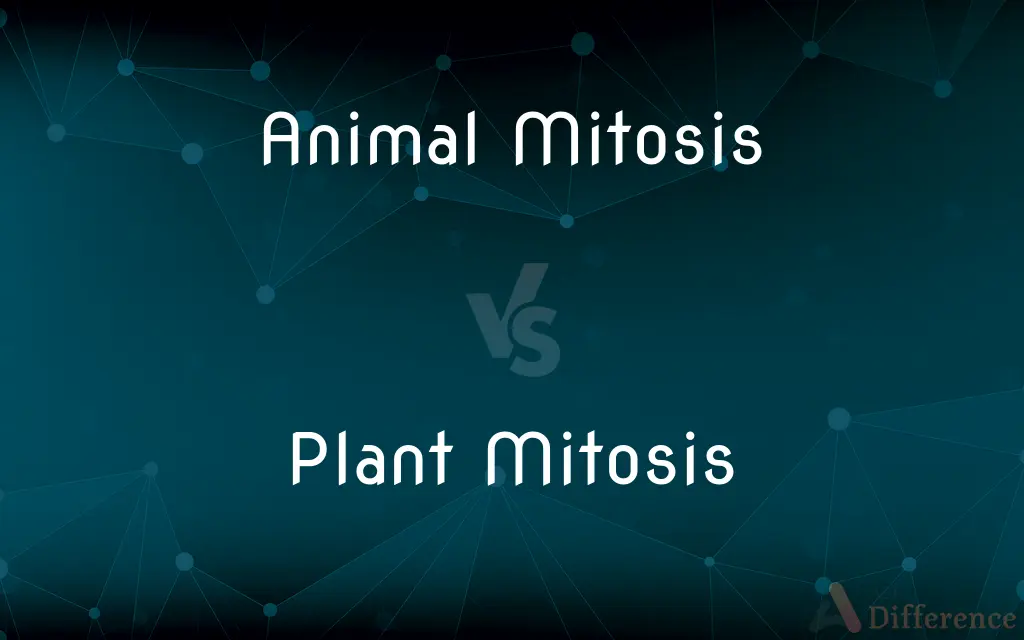Animal Mitosis vs. Plant Mitosis — What's the Difference?
By Tayyaba Rehman — Published on December 27, 2023
Animal Mitosis involves cell membrane pinching to form two daughter cells, while Plant Mitosis uses a cell plate to divide the cell.

Difference Between Animal Mitosis and Plant Mitosis
Table of Contents
ADVERTISEMENT
Key Differences
Animal Mitosis is the process by which animal cells divide their nucleus and contents to form two identical daughter cells. In contrast, Plant Mitosis refers to the division in plant cells where a cell plate forms to segregate the two developing nuclei.
During Animal Mitosis, the cell membrane, or cytokinesis, pinches inwards, eventually leading to the separation of the two daughter cells. In Plant Mitosis, due to the presence of a rigid cell wall, a cell plate forms in the middle of the cell, which then develops into a cell wall separating the two daughter cells.
One distinguishing feature of Animal Mitosis is the formation of centrioles, which are absent in most plant cells. In Plant Mitosis, there are no centrioles; instead, microtubules help in chromosome separation.
Animal Mitosis tends to be a quicker process, facilitated by the flexible nature of animal cell membranes. On the other hand, Plant Mitosis is a slightly more complex process given the rigidity of plant cell walls and the necessity to form a new cell wall.
Both Animal Mitosis and Plant Mitosis serve the same essential purpose: to ensure growth, repair, and maintenance of the organism. However, the methods by which each type of cell undergoes division differ due to their structural differences.
ADVERTISEMENT
Comparison Chart
Division Method
Cell membrane pinches in
Cell plate forms and becomes cell wall
Centrioles
Present
Absent
Speed
Generally quicker
Slightly slower due to cell plate formation
Primary Purpose
Growth, repair, and regeneration
Growth and repair
Structural Features Influencing Process
Flexible cell membrane
Rigid cell wall
Compare with Definitions
Animal Mitosis
Cellular division process in animals.
Animal Mitosis ensures healing by replacing damaged cells with new ones.
Plant Mitosis
Division process where a cell plate forms.
The cell plate in Plant Mitosis eventually becomes the cell wall, separating the two daughter cells.
Animal Mitosis
A process facilitated by centrioles in animal cells.
Centrioles play a crucial role in chromosome separation during Animal Mitosis.
Plant Mitosis
Method for producing two genetically identical plant cells.
Through Plant Mitosis, plants can expand their size and repair damaged tissues.
Animal Mitosis
Method for producing two genetically identical animal cells.
Through Animal Mitosis, organisms can grow and tissues can repair.
Plant Mitosis
A process occurring without the presence of centrioles.
Plant Mitosis relies on microtubules for chromosome separation due to the absence of centrioles.
Animal Mitosis
Division process with the cell membrane pinching inwards.
The pinching of the cell during Animal Mitosis leads to the formation of two daughter cells.
Plant Mitosis
Ensures growth and repair in plants.
Regular occurrences of Plant Mitosis lead to the expansion of roots, stems, and leaves.
Animal Mitosis
Ensures maintenance of animal tissues.
Regular occurrences of Animal Mitosis maintain the health of tissues in an organism.
Plant Mitosis
Cellular division process in plants.
Plant Mitosis ensures the growth of a plant from a seedling to a mature plant.
Common Curiosities
How does Animal Mitosis differ from Plant Mitosis?
Animal Mitosis involves cell membrane pinching, while Plant Mitosis involves cell plate formation.
Are centrioles present in Plant Mitosis?
No, centrioles are absent in most plant cells and hence do not play a role in Plant Mitosis.
Why do plant cells form a cell plate during Plant Mitosis?
Due to the rigid cell wall, plant cells form a cell plate which later becomes a cell wall, separating the daughter cells.
Which process is faster, Animal Mitosis or Plant Mitosis?
Animal Mitosis tends to be quicker due to the flexibility of the animal cell membrane.
Why is Animal Mitosis important?
Animal Mitosis ensures growth, repair, and regeneration of tissues in animals.
Is cytokinesis the same in Animal Mitosis and Plant Mitosis?
No, in Animal Mitosis, the cell membrane pinches inwards for cytokinesis, while in Plant Mitosis, a cell plate forms.
How does the rigid cell wall affect Plant Mitosis?
The rigid cell wall necessitates the formation of a cell plate, which eventually becomes a new cell wall.
Do both Animal Mitosis and Plant Mitosis result in two daughter cells?
Yes, both processes result in two genetically identical daughter cells.
Can cells undergoing Plant Mitosis produce genetically different offspring?
No, both Plant Mitosis and Animal Mitosis produce genetically identical daughter cells.
Why is Plant Mitosis essential for plants?
Plant Mitosis ensures the growth, development, and repair of plant tissues.
Is Animal Mitosis responsible for genetic diversity in populations?
No, Animal Mitosis produces genetically identical cells; genetic diversity arises from processes like meiosis and mutation.
Are the roles of microtubules similar in both Animal Mitosis and Plant Mitosis?
Yes, microtubules play crucial roles in chromosome separation in both processes.
How does the cell plate form during Plant Mitosis?
The cell plate forms at the center of the cell from vesicles carrying cell wall materials, eventually becoming the cell wall.
Which organisms exhibit Animal Mitosis?
All multicellular animals and many unicellular organisms undergo Animal Mitosis.
Does the absence of centrioles in Plant Mitosis affect chromosome separation?
No, even without centrioles, Plant Mitosis efficiently separates chromosomes using microtubules.
Share Your Discovery

Previous Comparison
Anomers vs. Epimers
Next Comparison
Save vs. Save AsAuthor Spotlight
Written by
Tayyaba RehmanTayyaba Rehman is a distinguished writer, currently serving as a primary contributor to askdifference.com. As a researcher in semantics and etymology, Tayyaba's passion for the complexity of languages and their distinctions has found a perfect home on the platform. Tayyaba delves into the intricacies of language, distinguishing between commonly confused words and phrases, thereby providing clarity for readers worldwide.
















































